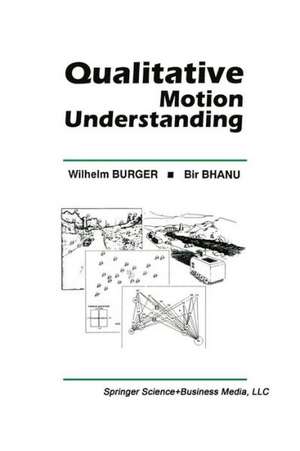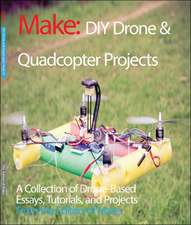Qualitative Motion Understanding: The Springer International Series in Engineering and Computer Science, cartea 184
Autor Wilhelm Burger, Bir Bhanuen Limba Engleză Paperback – 8 oct 2012
Qualitative Motion Understanding describes a qualitative approach to dynamic scene and motion analysis, called DRIVE (Dynamic Reasoning from Integrated Visual Evidence). The DRIVE system addresses the problems of (a) estimating the robot's egomotion, (b) reconstructing the observed 3-D scene structure; and (c) evaluating the motion of individual objects from a sequence of monocular images. The approach is based on the FOE (focus of expansion) concept, but it takes a somewhat unconventional route. The DRIVE system uses a qualitative scene model and a fuzzy focus of expansion to estimate robot motion from visual cues, to detect and track moving objects, and to construct and maintain a global dynamic reference model.
| Toate formatele și edițiile | Preț | Express |
|---|---|---|
| Paperback (1) | 983.71 lei 6-8 săpt. | |
| Springer Us – 8 oct 2012 | 983.71 lei 6-8 săpt. | |
| Hardback (1) | 989.96 lei 6-8 săpt. | |
| Springer Us – 30 iun 1992 | 989.96 lei 6-8 săpt. |
Din seria The Springer International Series in Engineering and Computer Science
- 24%
 Preț: 1041.97 lei
Preț: 1041.97 lei - 20%
 Preț: 643.50 lei
Preț: 643.50 lei - 18%
 Preț: 1225.62 lei
Preț: 1225.62 lei - 18%
 Preț: 965.02 lei
Preț: 965.02 lei - 20%
 Preț: 646.12 lei
Preț: 646.12 lei - 18%
 Preț: 948.79 lei
Preț: 948.79 lei - 20%
 Preț: 646.62 lei
Preț: 646.62 lei - 15%
 Preț: 637.46 lei
Preț: 637.46 lei - 20%
 Preț: 643.83 lei
Preț: 643.83 lei - 18%
 Preț: 949.23 lei
Preț: 949.23 lei - 20%
 Preț: 644.48 lei
Preț: 644.48 lei - 20%
 Preț: 994.92 lei
Preț: 994.92 lei - 20%
 Preț: 645.97 lei
Preț: 645.97 lei - 18%
 Preț: 946.87 lei
Preț: 946.87 lei - 20%
 Preț: 995.57 lei
Preț: 995.57 lei - 18%
 Preț: 956.99 lei
Preț: 956.99 lei - 20%
 Preț: 644.98 lei
Preț: 644.98 lei - 15%
 Preț: 649.54 lei
Preț: 649.54 lei - 18%
 Preț: 950.21 lei
Preț: 950.21 lei - 18%
 Preț: 1221.38 lei
Preț: 1221.38 lei - 18%
 Preț: 957.62 lei
Preț: 957.62 lei - 15%
 Preț: 643.99 lei
Preț: 643.99 lei - 18%
 Preț: 948.47 lei
Preț: 948.47 lei - 18%
 Preț: 947.35 lei
Preț: 947.35 lei - 20%
 Preț: 1284.65 lei
Preț: 1284.65 lei - 20%
 Preț: 1628.31 lei
Preț: 1628.31 lei - 20%
 Preț: 1285.78 lei
Preț: 1285.78 lei
Preț: 983.71 lei
Preț vechi: 1229.64 lei
-20% Nou
Puncte Express: 1476
Preț estimativ în valută:
188.24€ • 197.03$ • 156.67£
188.24€ • 197.03$ • 156.67£
Carte tipărită la comandă
Livrare economică 31 martie-14 aprilie
Preluare comenzi: 021 569.72.76
Specificații
ISBN-13: 9781461365846
ISBN-10: 1461365848
Pagini: 228
Ilustrații: XIII, 210 p.
Dimensiuni: 155 x 235 x 12 mm
Greutate: 0.33 kg
Ediția:Softcover reprint of the original 1st ed. 1992
Editura: Springer Us
Colecția Springer
Seria The Springer International Series in Engineering and Computer Science
Locul publicării:New York, NY, United States
ISBN-10: 1461365848
Pagini: 228
Ilustrații: XIII, 210 p.
Dimensiuni: 155 x 235 x 12 mm
Greutate: 0.33 kg
Ediția:Softcover reprint of the original 1st ed. 1992
Editura: Springer Us
Colecția Springer
Seria The Springer International Series in Engineering and Computer Science
Locul publicării:New York, NY, United States
Public țintă
ResearchCuprins
1 Introduction.- 1.1 Aims of Motion Understanding.- 1.2 Autonomous Land Vehicle Navigation.- 1.3 Multi-Level Vision and Motion Analysis.- 1.4 Approaches to Motion Understanding.- 1.5 Outline of this Book.- 2 Framework for Qualitative Motion Understanding.- 2.1 Moving Through a Changing Environment.- 2.2 The “DRIVE” Approach.- 2.3 Low-Level Motion.- 2.4 Camera Motion and Scene Structure.- 2.5 Detecting 3-D Motion.- 2.6 Qualitative Modeling and Reasoning.- 3 Eli ECTS OF CAMERA MOTION.- 3.1 Viewing Geometry.- 3.2 Effects of Camera Rotation.- 3.3 Computing the Camera Rotation Angles.- 3.4 Effects of Camera Translation.- 3.5 Computing the Translation Parameters.- 4 Decomposing Image Motion.- 4.1 Motion Between Successive Frames.- 4.2 FOE from Rotations.- 4.3 Rotations from FOE.- 5 THE FUZZY FOE.- 5.1 Avoiding Unrealistic Precision.- 5.2 Defining the Fuzzy FOE.- 5.3 Computing the Fuzzy FOE.- 5.4 Experiments.- 6 Reasoning about Structure and Motion.- 6.1 Abstracting Image Events.- 6.2 Interpreting Image Events.- 6.3 Reasoning About 3-D Scene Structure.- 6.4 Reasoning About 3-D Motion.- 7 The Qualitative Scene Model.- 7.1 Basic Elements of the Model.- 7.2 Representing Multiple Interpretations.- 7.3 Conflict Resolution.- 7.4 Dynamic Evolution of the QSM.- 8 EXAMPLES.- 8.1 Simulated Data.- 8.2 Real Data.- 8.3 Implementation Issues.- 9 SUMMARY.- A.1 Geometric Constraint Method for Camera Motion.- A.2 Estimating Absolute Velocity.- REFERENCES.











